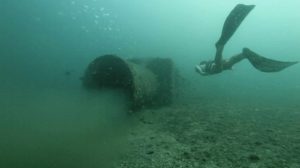
MALAGA AND COSTA DEL SOL: GREAT TOURIST AREA, WORRYING WASTEWATER PURIFICATION

With this article, I am detracting from the usual ones of a more legal nature, aimed at foreigners, resident or non-resident, who own a home in Malaga. In this post, I attempt to analyse the situation of wastewater purification in terms of the most significant tourist municipalities in Costa del Sol, as well as the financial and environmental consequences that lack of purification entails for municipalities like Nerja and Coín. I also focus on properties on rural land and the purification required for homes wishing to obtain a DAFO.
Introduction wastewater purification
With environmental sustainability or the environmental impact of our lifestyles being such an important issue in our times, I would like to speak my mind about the great problem of faecal water purification in the province of Malaga in general, even through it is sadly extensible to most regions in Spain, in population centres both large and small. However, Malaga, as a top tourist destination and due to its population density, especially along the coastline, should have an infrastructure that mitigates the environmental impact caused by all of us who live on the shore.
Many of our clients, both resident and non-resident, who are thinking about purchasing a home in Andalusia and that we provide advice to, are attracted by the Mediterranean Sea that bathes our shores but on which we indiscriminately dump millions of litres of unpurified wastewater. A recent article in La Opinión de Málaga on 5 January stated that Malaga dumps 123 million cubic metres of wastewater into the sea every year, a real atrocity.
National problem, million-euro fine
On 15 February, El País national newspaper published an article informing that, until that date, Spain had paid about 32.70 million euros in fines due to not complying with the wastewater treatment directive in municipalities with over 15,000 inhabitants. This has been the highest fine paid by Spain to the EU in history.
This breach of the directive led to a conviction from the European Court of Justice and the resulting fine being imposed by the European Commission. This fine continues to grow for as long as those 17 municipalities fail to treat their wastewater, an obligation that came into force in 2001, which means almost 19 years have passed since that directive was enacted.
Nerja, beautiful beaches with faecal waters
One of the many municipalities that have been fined and do not have a sewage treatment plant is Nerja. It is striking that this municipality, which such beauty and such great beaches and cliffs, in 2020, is still dumping the sewage it generates directly into the ocean, through a collector located 1,200 metres from the coast.
Nerja has spent over 20 years on the project for its sewage treatment plant and even though it seems that this year may finally mark the end of the works, according to an article in Diario Sur on 6 January (fingers crossed), this does not detract from the sloppiness and lack of interest of the local and regional government have displayed about this project.
The situation is so obvious from an environmental standpoint that, following several complaints, the prosecutor’s office brought judicial proceedings against senior officials of the Nerja City Council for the illegal dumping of this untreated wastewater. One of the toxicology reports certified that all samples taken from five beaches in Nerja contained faecal organisms according to their tests.
Construction of the Nerja treatment plant was declared to be of public interest by the Government in 1996 but, 23 years later, it has not yet been completed. If you visited Nerja and the surrounding areas in 1996, you could see the large number of works that did get started and completed because there were many years with large capital movements but the faecal water purification plant was not so lucky. Other municipalities on the eastern coast, such as Torrox, Vélez Málaga and Rincón de la Victoria, do have a sewage treatment plant in operation.
Mouth of the Guadalhorce, a natural site with a “faecal” river
Another area that also presents a high degree of pollution due to illegal dumping is the mouth of the Guadalhorce river in the city of Malaga. This enclave is the last unspoiled beach in the city of Malaga and is home to a very significant ecosystem of flora and fauna, with a network of trails to move through it. However, in this river, municipalities as large as Alhaurín el Grande and Coín dump their untreated faecal waters, which also led to a fine being paid by the government of Spain.
The city of Malaga has reinvented itself as a multicultural European city, currently highly appreciated by foreign tourists due to its many urban development projects, mostly in real estate. But Malaga is unable to commit to a project in the mouth of the Guadalhorce, which could affect this unique space –as it is the last unspoiled one– to preserve its environmental value.
It is non-profit associations that are reforesting and trying to preserve this space altruistically, as our firm was able to witness during the conference we held with some of them last November.
The municipality of Coín, a peculiar case
For the town of Coín to be able to connect to the treatment plant in the lower Guadalhorce, it is necessary to build the 3 kilometres of collectors that were destroyed by the torrential rains in autumn 2018 but the Andalusia Council, along with the contracting company, continue to fight to decide who will pay for these repairs. Coín is also immersed in legal proceedings due to its failure to treat its wastewater. While the administrations argue, this collector continues broken and the faecal water from Coín is dumped directly into the Guadalhorce river.
Isolated homes and their regularisation through DAFO, a bad focus of faecal waters
Even though compared to large population centres, the impact of these homes is lower, it should be noted that there are many isolated homes existing in Malaga. In La Axarquía, municipalities such as Alcaucín, Viñuela, Competa, Periana and Torrox have thousands of rural homes, as well as towns in the Guadalhorce valley, such as Coín, Alhaurín el Grande and Alhaurín de la Torre. Likewise, municipalities such as Mijas or Ronda also have many houses on non-urban land.
Among the positive aspects of the DAFO these homes are required to have an individual and autonomous treatment system. It should be noted that this procedure is important for foreigners who buy and sell homes in the province.
What is the problem?
I see that one of the negative aspects is the requirement from the Andalusia Council for properties subject to DAFO to have a watertight septic tank, forbidding septic tanks with a biological filter. This guideline is a serious mistake and its effect is contrary to what is intended, which is to prevent these homes from polluting the land on which they are located.
Properties with a watertight tank habitually require (monthly or more frequently, depending on their use) a tanker to visit the property and empty the contents of the tank, which are then transferred to an authorised waste facility.
What is the alternative?
Allowing the use of septic tanks with a biological filter as a treatment system, as it would not be necessary to empty the tank and water would come out clean and purified. It may be necessary to request authorisation for the discharge point of this clean, filtered water, which could even be used for irrigation but, with this treatment system, a company would only need to clean the tanks once a year, which represents significant savings for owners.
What is happening?
The problem that we find with watertight septic tanks is the economic cost of each emptying, which leads many homeowners to resort to other illegal methods, to avoid inconveniences and economic costs. In many cases, they choose to install a watertight septic tank and, once the technician certifies it, a small hole is drilled at the bottom, through which faecal water is poured into groundwater, thereby dispending with the need to have a truck empty it and making it very difficult for this to be sanctioned.
It is appalling that, in some cities, it has been accepted or assumed that owners will not empty their watertight septic tanks and will drill a small hole in them. I would even dare to say that owners are given such a “solution” to prevent the inconvenience of emptying, as the DAFO only requires having a technician certify the installation of the watertight septic tank and, if a hole is drilled later, no one will notice.
However, with thousands of homes in the countryside, thinking that a truck would need to go empty the septic tank in each of them on a frequent basis, requires being naive or means that the Andalusia Council cares little about these discharges (I lean more towards the latter). I am also not very sure of where these trucks discharge the faecal waters they do collect.
Do not pollute the environment if you process the DAFO for your property
To prevent the situation above, which is absolutely filthy, in some of the DAFO we have processed, we have found this problem and, to prevent faecal waters from being discharged directly into the ground, we have advised owners that, once the watertight tank is installed and certified to process the DAFO, they install one with a biological filter next to it. This way, at least, the water they dump will be clean and not pollute the ground, while the owner will avoid all the financial cost and disruption entailed by emptying the tank periodically.
At least, with the second option, despite not being accepted officially by the Junta of Andalusian and many municipalities, faecal discharge is prevented, which is the main goal when it comes to the environment.
Conclusion
As you probably understand, this issue goes a long way but I believe that, with these few brushstrokes, you can see the general lack of environmental awareness in the administration as well as among many citizens. This is the sad reality.
Tourism in Malaga and the entire Mediterranean area is also not viewed with a perspective for the future, as we live in the short term and do not care for essential things for investors and tourists to continue to come to Malaga, as well as foreigners wishing to purchase a home to enjoy a high quality of life or just spend their holidays in Span.
Meanwhile, those of us who reside and live here most of the time are unaware of the large amount of pollution we generate and the damage we cause to the sea, rivers and streams (which are increasingly polluted). I do not see many complaints or movements among citizens protesting this situation.
Some of the damage is already irreparable but there is some that can be fixed.
Author: Gustavo Calero Monereo, lawyer at C&D Solicitors Torrox (Málaga, Andalusia)

